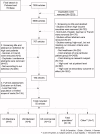Systematic review of high-cost patients' characteristics and healthcare utilisation
- PMID: 30196269
- PMCID: PMC6129088
- DOI: 10.1136/bmjopen-2018-023113
Systematic review of high-cost patients' characteristics and healthcare utilisation
Abstract
Objectives: To investigate the characteristics and healthcare utilisation of high-cost patients and to compare high-cost patients across payers and countries.
Design: Systematic review.
Data sources: PubMed and Embase databases were searched until 30 October 2017.
Eligibility criteria and outcomes: Our final search was built on three themes: 'high-cost', 'patients', and 'cost' and 'cost analysis'. We included articles that reported characteristics and utilisation of the top-X% (eg, top-5% and top-10%) patients of costs of a given population. Analyses were limited to studies that covered a broad range of services, across the continuum of care. Andersen's behavioural model was used to categorise characteristics and determinants into predisposing, enabling and need characteristics.
Results: The studies pointed to a high prevalence of multiple (chronic) conditions to explain high-cost patients' utilisation. Besides, we found a high prevalence of mental illness across all studies and a prevalence higher than 30% in US Medicaid and total population studies. Furthermore, we found that high costs were associated with increasing age but that still more than halve of high-cost patients were younger than 65 years. High costs were associated with higher incomes in the USA but with lower incomes elsewhere. Preventable spending was estimated at maximally 10% of spending. The top-10%, top-5% and top-1% high-cost patients accounted for respectively 68%, 55% and 24% of costs within a given year. Spending persistency varied between 24% and 48%. Finally, we found that no more than 30% of high-cost patients are in their last year of life.
Conclusions: High-cost patients make up the sickest and most complex populations, and their high utilisation is primarily explained by high levels of chronic and mental illness. High-cost patients are diverse populations and vary across payer types and countries. Tailored interventions are needed to meet the needs of high-cost patients and to avoid waste of scarce resources.
Keywords: health care costs; health care utilization; high-need high-cost; integrated delivery of health care.
© Author(s) (or their employer(s)) 2018. Re-use permitted under CC BY-NC. No commercial re-use. See rights and permissions. Published by BMJ.
Conflict of interest statement
Competing interests: None declared.
References
Publication types
MeSH terms
LinkOut - more resources
Full Text Sources
Other Literature Sources
Research Materials

